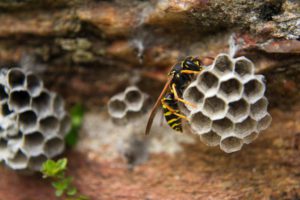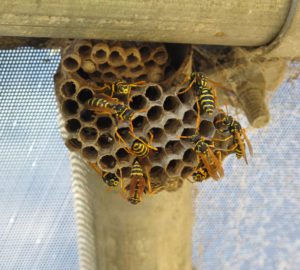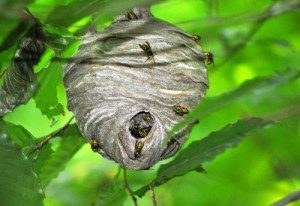Finding a wasp nest near your home is always an unpleasant surprise, especially if you have outdoor pets or children who play outside frequently.

Wasps can be particularly dangerous to people who have allergic reactions to their stings, so it is important to get rid of a wasp nest quickly once you’ve located it.
While the easiest way to get rid of a wasp nest is to call a Maryland pest control service company and have them handle it, you can also try removing the wasp nest yourself.
Check out the following tips so you can get prepared, remove the nest safely, and prevent wasps from returning in the future.
Preparing for a Wasp Nest Removal
If you’ve ever been stung by a wasp, then you probably already understand why removing a wasp nest near your home should not be taken lightly. Their stings can be incredibly painful and especially dangerous for those with allergies.
Here’s how you can get prepared to remove a wasp nest safely:
Schedule an Allergy Test
Because of the risks involved with wasp stings, you should schedule an allergy test with your doctor to make sure that you are not allergic before you try to remove the nest or go anywhere near it. Otherwise, you may suffer a severe allergic reaction known as anaphylaxis, which can cause severe swelling, breathing difficulties, vomiting, racing pulse, and more.
Protect Yourself with Clothing
To avoid getting stung, you should always wear protective clothing when near a wasp nest. This especially applies if you’re going to attempt to remove it since you may end up stirring some wasps up in the process.
Here are a few tips for getting dressed before you remove a wasp nest:
- Try to cover as much of your skin as you can. Wear gloves, protective glasses, long pants, socks, shoes, a long-sleeved shirt and/or hoodie, hat, and a scarf.
- Use your scarf to cover the lower half of your face rather than just wrapping it around your neck.
- You’ll need to wash or throw away the clothes after you’re done removing the nest, so don’t wear anything you wouldn’t be willing to part with.
Plan a Getaway Route
Even the best plan for getting rid of a wasp nest could fail, so it’s important for you to think of how you will escape if a swarm of wasps begins to chase you. Make sure that you have a way to quickly take cover in case your wasp nest removal doesn’t go as smoothly as planned.
3 Methods of Removing the Wasp Nest

- Insecticide
- First, you’ll need to verify that your insect spray is specifically made to get rid of wasps. You should have two cans of aerosol bug spray with you when you attempt to remove the nest.
- First, spray the insecticide directly into the opening at the bottom of the nest for at least ten seconds. After that, you can start spraying any other openings that you see on the nest. Do this for as long as you safely can, and then leave the area quickly. If wasps start to follow you, don’t panic – simply use your planned evacuation route to avoid them.
- Soap and water
- If you’d prefer not to use insecticide, you can use soap and water to get rid of the wasp nest. To do this, you’ll need to first mix four tablespoons of dish soap (any brand will work!) with one quart of water.
- Then, put the solution into a spray bottle or water gun. You’ll need to stay at least 10 feet away from the nest when you spray it, so make sure that your spray bottle/water gun can spray far enough. That way, you won’t have to get close to the nest and endanger yourself.
- Once you’re ready, start spraying. Be sure to soak the nest completely. When you do this, the wasps will not be able to breathe anymore and they will die. When this happens, you can safely knock the nest down to prevent any other wasps from returning to it.
- Smoke
- To use this method, start by building a small fire below the wasp nest. When smoke begins to rise from the fire, the wasps will begin to suffocate and they will be forced to leave the nest.
- You need to let the smoke continue rising for at least one hour before you attempt to remove the nest. When an hour has passed (you can wait 2 hours for extra reassurance), knock the wasp nest down with a stick and get rid of it.
- Keep in mind that you should avoid using this method if the nest is close to your home. Otherwise, you may end up accidentally setting your house on fire and/or injuring someone.
Wasp Prevention

Remove Fallen Fruit
If there are fruit trees near your house, beware – fallen fruit attracts wasps. Make sure that you pick up any fallen fruit regularly and dispose of it properly so you can help keep wasps far from your home.
Cover Drinks/Food
Food and drinks – especially proteins and sweet drinks – can attract an unpleasant amount of wasps. Next time you’re eating outdoors or hosting the neighborhood barbecue, make sure you let everyone know to cover any food/drinks so wasps don’t show up and put a damper on your day.
Seal Trash Cans/Entry Points
Wasps may flock to an unsealed garbage can because the scent of old food attracts them, so be sure that your trash can is sealed tightly. You should also seal any entry points (holes/cracks/crevices) on the outside of your home so that wasps cannot make a nest there. Check around your windows and door frames for these entry points.
If you feel unsure about removing a wasp nest or preventing wasps in the future, reach out to the Maryland pest control services team at Brody Brothers Pest Control.
We understand that wasps can be both dangerous and a nuisance, especially if you spend a lot of time outdoors. Our team can help you stay safe from wasps and avoid the hassle of dealing with them.
Ready to get rid of wasps or prevent a future infestation? Contact our Maryland pest control team today!

